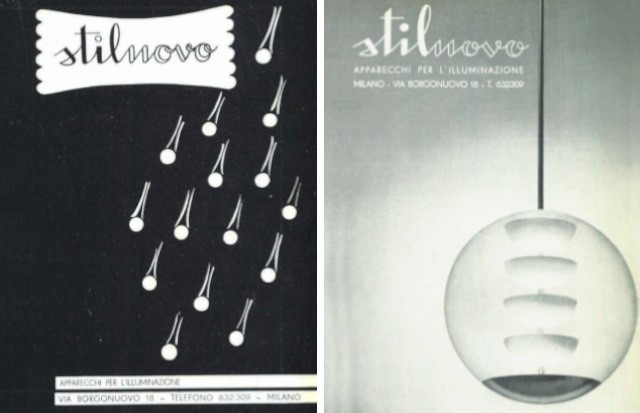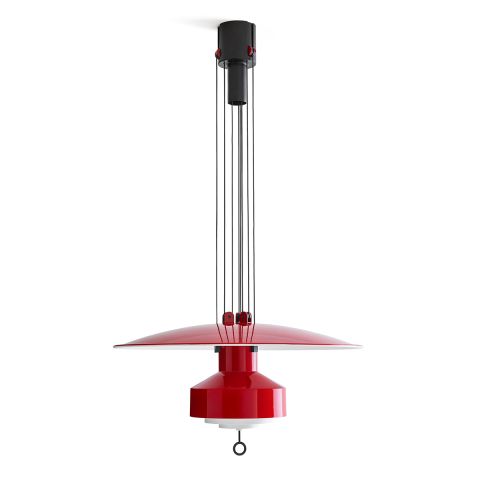Stilnovo - New Style

Exploring Stilnovo’s historical lighting products and their cutting edge reissues
As a team of design enthusiasts, Stilnovo’s historical products have long been admired by us for their ingenuity and sophistication, as well as for their daring and irreverent character. Recently acquired by Linea Lighting Group, last month we welcomed three reissued icons from Stilnovo into our showroom at 110 Drury Lane - namely the Saliscendi, the Lampiatta and the Fante. Here, we share the compelling story of the progressive, twentieth-century Italian modern lighting producer - whose name means ‘new style’.
A compelling history
In 1946, Bruno Gatta founded Stilnovo as a publishing house in Milan. The following year, Stilnovo participated in the VIII Triennale di Milano, launching alongside it a communications campaign that focused on the most prestigious and niche magazines in the sector.

Left: Stilnovo advertisement for the VIII Triennale, 1947. Right: Stilnovo advertisement, 1949.
By 1949, Bruno Gatta’s brother, Paolo, had joined the business and together they opened Stilnovo Srl. Operating in the manufacture of lighting and in accordance with a true industrial logic, they became known for their experiments in new materials, streamlined shapes, and innovative production methods. Later opening a new site in Milan at Via Durini 26, within a few years the company would become a point of reference for all twentieth-century lighting producers.
In the 1950s, the majority of Stilnovo’s designs were conceived in-house by the company’s technical office. Having originally trained as an architect and filmmaker, Angelo Gaetano Sciolari’s experience at the helm of his family’s business - Sciolari Lighting - led to his appointment as Stilnovo’s in-house designer from the 1950s until the late 1960s.
Also in the 1950s, Achille and Pier Giacomo Castiglioni were commissioned for the planning and reconstruction of the Milan Chamber of Commerce, which had been partially destroyed by wartime bombings. In 1957, the brothers imagined two pendant lamps to be installed in the Salla della Guinta, a meeting room with a large central table where they imagined a lighting system that would disperse both direct light onto the table and diffuse light to the rest of the room for a strong emotional impact. And so the Saliscendi, which translates roughly as ‘rise and fall’, was born - an adjustable, dual-emission pendant lamp with a system of pulleys that, with a simple gesture, could slide along the cables to reposition its light source, as well as bring its reflective disk closer or further away for the perfect distribution of lighting.

Working sketch of the Saliscendi Pendant Lamp prototypes. Image courtesy of Fondazione Achille Castiglioni.
In order to realise such a complex system, the Castiglioni brothers turned to Stilnovo for their manufacturing expertise. Together, they produced two prototypes in glossy ruby-red lacquer work that were installed in the Milan Chamber of Commerce in 1958. Due to their complexity, no further production would occur - at least not until the twenty-first century.

The original prototypes of the Saliscendi Pendant Lamp at the Milan Chamber of Commerce. Image courtesy of Fondazione Achille Castiglioni.
Following its contribution to the Milan Chamber of Commerce, Stilnovo Srl began to receive its first major orders from prominent architects resulting in the development of its large scale contract projects - the most renowned of which was the Galfa Tower, a 109 metre skyscraper designed by architect Melchiorre Bega in the International Style. As a result of this exponential growth, a new, ultra-modern factory in Lainate was opened.

Left: Galfa Tower. Right: Galfa Tower interior with 5011 Suspension Lamps designed by Gaetano Sciolari. Photographer and date unknown.
To further distinguish itself from other modern lighting companies, in 1969 Stilnovo enlisted Giancarlo Iliprandi as branding officer and Italo Lupi as head of visual communications.

Left: Stilnovo catalogue, 1968. Right: Minitopo Table Lamp by Joe Colombo as featured Stilnovo’s catalogue, 1973.
Presenting itself as a dynamic brand, throughout the 1960s and 1970s Stilnovo collaborated with leading design figures and studios on new, progressive designs: from the Gravita designed by Italian graphic artist Antonio Macchi Cassia, to designs by Italian architects and industrial designers Joe Colombo, Ettore Sottsass and Gae Aulenti.

Left: Gravita Table Lamp as featured in Stilnovo‘s catalogue, 1969. Right: Triedro Pendant Lamps by Joe Colombo as featured in Stilnovo’s catalogue, 1976.
In contrast to the traditional references of Sciolini’s designs, these external collaborations were aligned towards a more futuristic aesthetic, which resulted in Stilnovo being invited to participate in ‘Italy, the New Domestic Landscape’, a 1972 exhibition at the Museum of Modern Art, New York.

Pages from ‘Italy, the New Domestic Landscape’ catalogue. Published by Museum of Modern Art, New York.
Designed by Studio De Pas, D’Urbino, Lomazzi in 1971, the Lampiatta exemplified this departure from staunch modernism with its aluminium parabola lampshade and system of slots.

Left: Lampiatta Table Lamp as featured in Stilnovo’s catalogue, 1973. Right: Lampiatta Table Lamp.
Culturally significant and with work represented in the permanent collections of the world’s most prominent museums, Jonathan De Pas, Donato D’Urbino and Paolo Lomazzi were well known for their humorous, ironic and pop-inspired style - from the 1967 inflatable armchair, aptly titled Blow, to the Joe Armchair.

Left: De Pas, D’Urbino and Lomazzi with Blow Armchair. Photographer and date unknown. Right: Joe Armchair in the ‘Italy, the New Domestic Landscape’ catalogue. Published by Museum of Modern Art, New York.
Designed by the trio in 1978, the Fante presented an equally characterful solution. With a conical silicone base and an adjustable aluminium reflector reminiscent of a ladies wide-brimmed hat, the shade could be moved around the light source freely.

Left: Fante Table Lamp as featured in Stilnovo’s catalogue, 1979. Right: Fante Table Lamp.
Although the company slowed to a halt in 1988, in 2019 it was reinvigorated thanks to its acquisition by the Linea Lighting Group, a global leader in LED lighting. Resuming its history and looking towards the future, in addition to the production of contemporary designs, Stilnovo has re-issued its historical products using Linea’s cutting-edge technology.
A testament to this partnership, more than six decades after the production of the first prototypes for the Milan Chamber of Commerce, among others the Saliscendi has been relaunched in an updated version that draws upon material provided by Stilnovo’s archives and the heirs of Achille and Pier Giacomo Castiglioni. Its inclusion in the ADI Design Index and the shortlist for the XXVIII Compasso d’Oro ADI Award, 2024 - the most prestigious award available in the production and design of high quality products - recognises it as the very best of Italian design in production today.

Left: Saliscendi Pendant Lamp prototypes in the Milan Chamber of Commerce, 1958. Image courtesy of Fondazione Achille Castiglioni. Right: Saliscendi Pendant Lamp.





